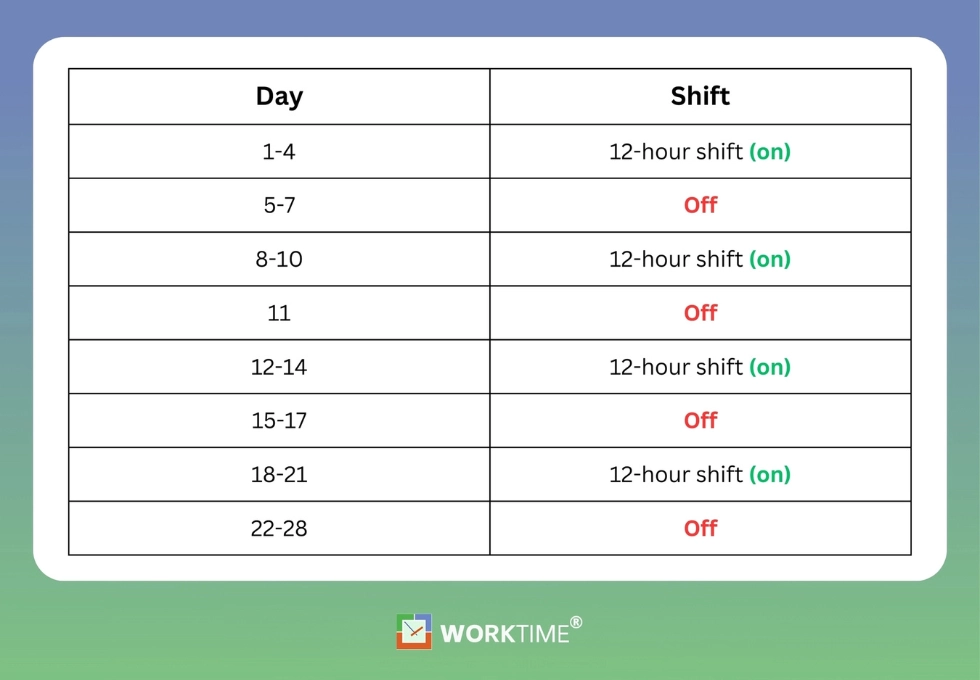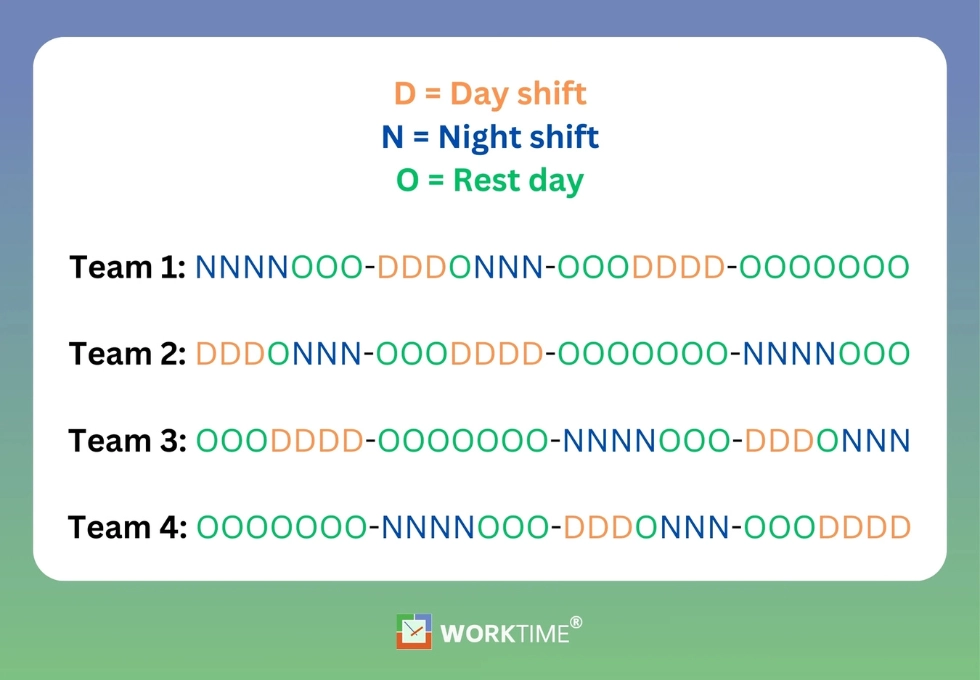2-2-3 schedule, a.k.a. Panama schedule: how does it work?
The DuPont shift pattern: the must-know facts What is the DuPont schedule? How does the Dupont shift schedule look? The origins of the DuPont schedule Evolution and variations Operational efficiency Health and employee satisfaction Acceptance beyond DuPont How does the DuPont schedule differ from the 2-2-3 schedule? 4-10 schedule Rotating shift schedule Swing shift schedule Pitman schedule In which industries is the DuPont schedule typically used? What are the advantages of the DuPont schedule? Predictability Fewer shift turnovers Reduction of overtime work Schedule flexibility Reduction of overtime work Extended breaks What are the disadvantages of the DuPont schedule? Potential burnout Rapid rotation Long shifts Training & supervision Work-life balance Uniformity of statement Health issues Employee resistance Decreased vigilance Possible problems with overwork Does the DuPont schedule suit my team? Bottom lineKey takeaways
Industries with extended work hours need shift schedules (e.g., in 24/7-attendance businesses like healthcare). That is because managers find it challenging to lead a team when employees struggle with long and unpredictable shifts. Luckily, the DuPont shift schedule may simplify this process and help your team manage work and life. DuPont's working arrangement comprises four teams, each alternating between day and night shifts evenly across a four-week cycle. The standard DuPont shift schedule entails 14 shifts lasting 12 hours each, resulting in an average of 42 weekly working hours. Nonetheless, certain weeks may involve up to six workdays, totaling 72 hours of work. The work schedule at DuPont is one of the most convenient and adaptable 12-hour plans; yet, if it is not applied appropriately, it can be challenging to adhere to the schedule. The question is how to plan and implement this schedule and whether other alternatives may work for you.Everything will be running well on your team with WorkTime: excellent attendance, active time, and employee productivity - all offered by this unique monitoring software!
What is a DuPont schedule?
A DuPont shift schedule is just one of many types of 12-hour working shift schedules. Companies use it to ensure continuous operation by providing employees with a combination of workdays and consecutive weekends. The advantages of such a schedule include longer rest periods, which can be beneficial for relaxation and recuperation. However, extended shifts and frequent rotation between day and night work may pose challenges for some employees. This cycle repeats every 28 days, meaning that employees work a total of 14 days in a 28-day period. The schedule alternates between day and night shifts, which can be challenging for some employees because it can disrupt sleep patterns and circadian rhythms. With so many working shifts available, you may get a bit lost. The question is whether DuPont is the right choice for your business and employees. Should you think about implementing other schedules?This blog examines the DuPont schedule 2024 and how to use it. We will also offer leadership tips for following the DuPont work schedule.With more than 20 years of experience in employee monitoring, WorkTime knows how to detect the perfect schedule and track hours, no matter which shift you prefer. Keep track of your staff performance under any conditions!
How does the Dupont shift schedule look?
Here is the basic information on how the DuPont shift schedule calendar typically functions:- Four days later: The employee works four consecutive 12-hour shifts.
- Three days off: The employee is granted three days of vacation.
- Three days later: The employee works three consecutive 12-hour shifts.
- One day off: The employee is granted one day off.
- Three days later: The employee works three consecutive 12-hour shifts.
- Three days off: The employee is granted three days of vacation.
- Four days later: The employee works four consecutive 12-hour shifts.
- Seven days off: The employee obtains a full week of vacation.

WorkTime is here to make your active and idle work time estimations simple and accurate! You can use this table as a DuPont work schedule template.
During the cycle, workers stay on the same shift until their team changes. Some businesses use a set version of this shift and have day and night teams that work all the time. This schedule has a slower turn than the DuPont schedule, which gives staff time to get used to the new conditions.The origins of the DuPont shift work schedule
The DuPont schedule, which got its name from the legendary DuPont Company, is a revolving shift plan created to accommodate different staff needs and operational requirements. The company's history and ongoing operations are closely linked to the history of the DuPont timetable. When DuPont was established in 1802, its initial product was gunpowder. Over the years, as the organization expanded its portfolio of products, numerous operations necessitated continuous processes that could not be initiated and terminated on a daily basis. This demanded a personnel pool with the capacity to maintain operations around-the-clock, every day of the week.Evolution and variations
Over time, as the benefits and challenges of the 12 hour DuPont schedule became apparent, variations of the schedule were developed. Some companies modified DuPont schedule to better fit their specific operational needs or to incorporate worker feedback. In creating comfortable working schedules, WorkTime might be the perfect time tracking software.Operational efficiency
DuPont's timetable also considered the requirements of business operations. In companies who implemented this schedule, reduced shift turnover resulted in a decrease in the likelihood of errors or failures occurring during these transitional times.Furthermore, implementing 12-hour shifts resulted in a decrease in the overall number of shifts and hence minimized the total turnover for a specific week.
Health and employee satisfaction
In ongoing operations with traditional 8-hour shifts, workers often had to switch shifts, sometimes once a week. It was discovered that this kind of frequent rotation is worse for workers' sleep habits and health than longer 12-hour shifts. As a possible solution to this problem, the monthly DuPont schedule calendar was created. It has both work days and days off, with long breaks between working several days in a row.Acceptance beyond DuPont
Following DuPont's schedule's success, other companies with continuous operations, including those in the chemical, manufacturing, and medical industries, have adopted it. Industries that need coverage at all times have begun to employ it extensively, along with employee monitoring solutions. It is important to note that, while the DuPont timetable has advantages, some pitfalls are obvious as well. Extended 12-hour hours can be exhausting, and the abrupt transition between day and night shifts may be difficult for certain employees. However, lengthier periods of rest and a reduction in the number of days worked per month are frequently regarded as compensatory benefits.How does the DuPont schedule differ from the 2-2-3 schedule?
Both the DuPont work schedule and the 2-2-3 schedule are 12-hour shift schedules designed to provide 24-hour work 24 days a week. However, they have different workday and weekend schedules. Here's a breakdown of the differences:- Working cycles: The DuPont schedule has a cycle that lasts 28 days, while the 2-2-3 schedule has a cycle that lasts 14 days.
- Working days in a row: On the DuPont schedule, workers can work up to four days in a row, but on the 2-2-3 schedule, they can only work three days in a row.
- Weekends in a row: The DuPont schedule lets you take up to seven days off in a row, while the 2-2-3 schedule lets you take up to three days off in a row.
- Weekend rotation: The 2-2-3 plan makes sure that workers get two full days off every other weekend, which isn't always the case with the DuPont work schedule.
You may tell the difference between DuPont and other schedules as well by knowing their definitions. No matter which one you choose, WorkTime will help you keep an eye on your staff performance!
4-10 schedule
One common DuPont schedule example is the 4-10 schedule, in which workers are required to put in four days of work of ten hours each and then take three days off. It is beneficial for employees to have extended days off because it allows them to cut the amount of time and money spent commuting.Rotating shift schedule
In 24/7 industries, including healthcare, manufacturing, and public safety, shift rotation is widespread. Employees rotate between day, evening, and night shifts. Rotating shifts allow organizations to operate continuously, but they might disrupt employees' circadian cycles and personal life.Swing shift schedule
The official definition of a swing shift is the period of time between the day and night duties. A secondary definition of swing shift pertains to a cohort of factory laborers who are available to work on an as-required basis, seven days a week. This facilitates uninterrupted production by permitting routinely scheduled employees to take one or more days off per week.Pitman schedule
Many confuse the DuPont work schedule with the Pitman schedule. The Pitman schedule makes the difference. Teams complete two or three sets of day and night shifts in a row over the course of 14 days.Until the end of the cycle, when their team is rotated, employees maintain a consistent shift sequence. Some businesses follow a more rigid schedule with dedicated day and night shifts.
In which industries is the DuPont schedule typically used?
The DuPont schedule is used in industries that require around-the-clock work. They often use special monitoring tools to support high levels of productivity. Some of the industries that commonly use or have used the DuPont schedule include:- Healthcare: 24-hour shift schedules are occasionally implemented by hospitals and other medical institutions that require continuous operation without days off, although they may not always align precisely with the DuPont work schedule.
- Public safety: emergency medical services (EMS) and fire departments frequently necessitate uninterrupted staffing and may implement diverse 12-hour shift timetables.
- Oil & gas: this type of schedule can be used by refineries and drilling sites that often work nonstop.
- Transport & logistics: the DuPont schedule or a version of it may be used at transportation hubs or sites that need to be open 24 hours a day, seven days a week.
- Chemical & petrochemical: the DuPont company itself, which created this schedule, operates in the chemical industry. continuous processes in chemical plants often require round-the-clock monitoring and management.
- Manufacturing: some manufacturing plants, especially those with continuous production lines, use the DuPont schedule to ensure uninterrupted operations.
The pulp and paper sector, with its continuous production operations, may also use such timetables. Here is an example of the DuPont schedule:For 24/7 security and employee monitoring, facilities like data centers or high-security buildings can adopt the DuPont schedule for security personnel.

Make work scheduling a breeze with Workfeed!
Use a DuPont work schedule calculator that can be found online or make estimations manually.What are the advantages of the DuPont schedule?
In sectors that require activities around the clock, the DuPont shift schedule ensures continuous coverage without the need for frequent shift changes. This is a significant benefit for companies that require round-the-clock operations. As you can see, the DuPont schedule, like other 12-hour shift schedules, offers a number of benefits to both employers and employees. When accompanied with professional monitoring software like WorkTime, this schedule can be rather efficient. Here are some DuPont employee benefits.Predictability
The 28-day schedule cycle that DuPont scheduling uses offers employees the option to plan their personal lives around their work schedules, which in turn gives workers with predictability.Fewer shift turnovers
Reduced staff turnover is one benefit of a 12-hour shift over an 8-hour one. Since briefings, equipment handovers, and other transitional tasks often eat up time, this can lead to improved operational efficiency when employees leave.Reduction of overtime work
The extended shifts, which span a lengthier duration of time, frequently result in a decreased requirement for overtime labor due to the structured 12-hour shift schedule.Schedule flexibility
The DuPont work schedule possesses the capacity to be modified in accordance with particular operational requirements, including the implementation of fixed shifts or the alternation of day and night shifts.The DuPont timetable provides blocks of three or four consecutive days off, which enables employees to have extended times of rest or participate in activities more significant to them.
Extended breaks
One of the outstanding features of DuPont's schedule is the provision of a seven-day break. This extended rest period can be useful for recuperation and offer employees a mini-vacation without using vacation days. A 12-hour shift is preferred by some employees because it allows for longer rest times, which can lead to increased employee satisfaction. Increased job satisfaction and decreased staff turnover are two potential outcomes that can result from this. No worries: to ensure your workers do not cheat on you, just implement a solution from WorkTime. Increased team cohesion and collaboration might result from longer shifts, as employees work together more often. While the DuPont shift schedule has many benefits, it may not work for every company or employee. Some workers struggle with the abrupt switch between day and night shifts and 12-hour shifts. Organizations must examine the pros and cons and consider employee feedback before implementing such a timetable.What are the disadvantages of the DuPont schedule?
While the DuPont chart offers a number of advantages, it also has certain disadvantages. Here are some of the major disadvantages associated with the DuPont chart.Potential burnout
There is a possibility that working multiple lengthy shifts in a row could increase the risk of burnout. This is especially true for jobs that include high levels of stress or physical demands.Rapid rotation
The work pattern at DuPont frequently entails switching between day shifts and night shifts. This is referred to as rapid rotation. Thus, it is sometimes called a DuPont rotating schedule. The circadian rhythms can be thrown off by such quick rotation, which can eventually lead to sleep disorders and other health issues.Long shifts
12-hour shifts can be tiring both physically and mentally, especially for positions that require constant attention or physical activity. Working long hours can lead to fatigue, which can affect productivity and safety. Besides, they can decrease motivation and engagement unless the company applies time tracking software.Training & supervision
It is possible that longer shifts will result in periods of time during which less experienced employees will be unsupervised. This is the case if the shifts of these employees do not coincide with the work hours of senior personnel.Work-life balance
While extended weekends can be a boon for many, long workdays can make it difficult to balance work and personal life on weekdays. For example, it can be difficult for parents to spend time with their children during weekdays.Uniformity of statement
Twelve-hour schedules may not be conducive to all job functions, particularly those that demand an excessive degree of focus.Health issues
Research has shown that working longer hours may be associated with specific health concerns, such as cardiovascular difficulties, stress, and sleep disorders. These are only some of the health issues that may be connected to working longer hours.
Employee resistance
Twelve-hour schedules are not preferred by all employees. A resistance to the transition from the conventional eight-hour workdays may result in employee discontentment or heightened attrition.Decreased vigilance
As employees approach the end of a 12-hour shift, their alertness and productivity may decrease, increasing the likelihood of errors or accidents.Possible problems with overwork
If an employee stays a little longer after a 12-hour shift or comes in early, extra hours can add up quickly, which drives up the cost of labor.Does the DuPont shift schedule suit my team?
Identifying the preferences of your team members is crucial. Find out if your team is on board with such a timetable by polling them or having a conversation. Think about the unions and the legislation. Make sure the schedule obeys all the rules set out by the unions and any collective bargaining agreements. If you encounter any problems with the law or the contract, you should talk to an attorney or a union representative. Operational needs assessment is the first step, focusing on your team's requirements. The DuPont shift schedule 12-hour shift is particularly suitable for sectors demanding round-the-clock shift coverage, such as manufacturing, healthcare, and public safety.If your organization operates continuously, the DuPont work schedule may be a suitable option, especially if implemented along with the reliable employee monitoring solution like WorkTime.









